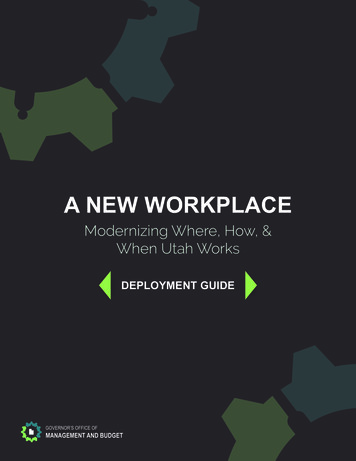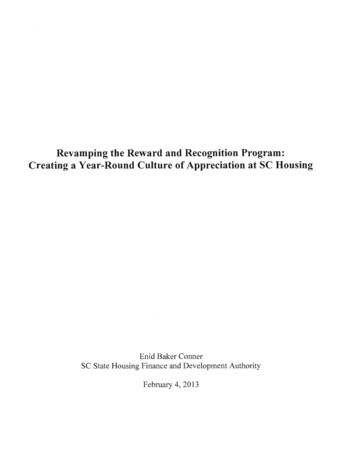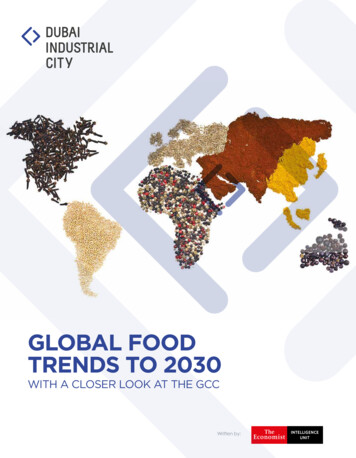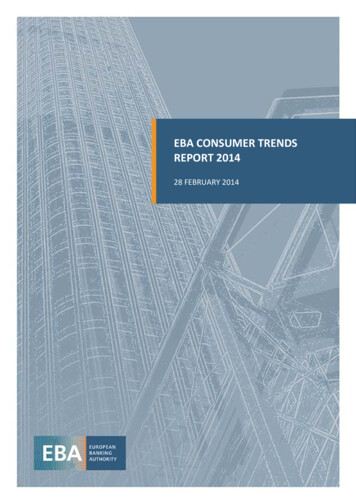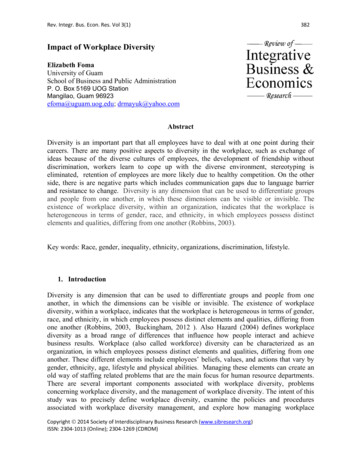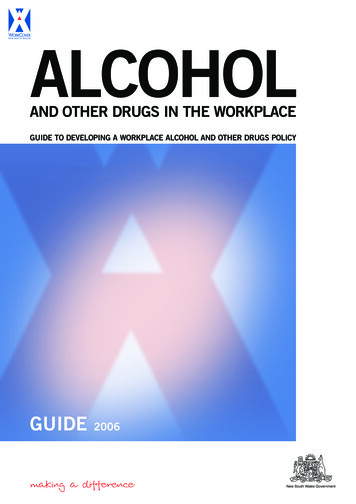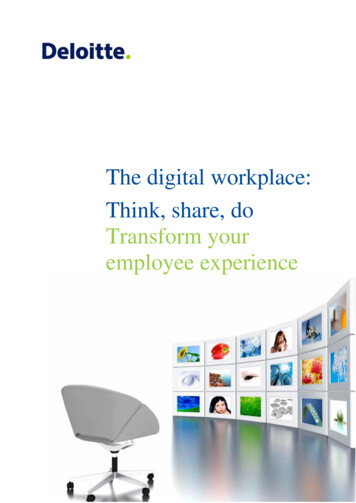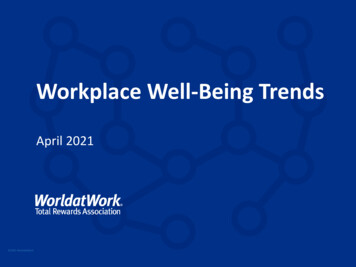
Transcription
Workplace Well-Being TrendsApril 2021 2021 WorldatWork 2021 WorldatWork
Content DirectoryMethodology .2Key Findings .3Workplace Well-Being Strategy. .7Culture of Well-Being .18Workplace Well-Being Programs .26Participant Profile . .30Topline Results .33Results by Group . Industry. 61Organization Size .81Employee Career Level. 101Employee Age. 108Employee Education Level. 115Employee Gender. 122Contact Us 1311 2021 WorldatWork
MethodologyIdentifyCollectAnalyzeWorldatWork invited its broader membership and customer base toparticipate in an electronic survey on U.S. workplace well-beingprograms. A total of 640 responses were received,representing organizations of different sizes across multiple industries.WorldatWork also obtained feedback from 501 full-time professionals inthe U.S. via the MarketCube panel online. The sample was sourcedprimarily based on gender, geography and age.Email invitations were sent directly to participants on March 1, 2021and results were collected over a 15-day period. The survey has a 3%overall margin of error at a confidence level of 95%. Sample sizes varyby question.Workforce well-being programs support an employee’s physical,emotional, or financial health and nurture a positive and productiveorganizational culture.Icon indicates the voice of the employee2 2021 WorldatWork
Key Findings 2021 WorldatWork 2021 WorldatWork
Rising Demand and Utilization of Well-Being Programs The importance of workplace well-being programs is escalating in recent months, notdeclining with the reduction of COIVD cases or vaccine accessibility. HR leaders perceivethat demand for well-being programs has increased (61%) as has utilization (63%). While 92% of organization’s make workplace well-being a priority, not all organizationshave a fully developed strategy or portfolio of offerings. 43% of employers are developingor implementing broader strategies; 28% are focused on sustaining current programs and26% are focused on advancing and innovating. 68% of employers include diversity, equity and inclusion (DEI) initiatives included as partof the organization’s well-being strategy the impact is real: 60% of employees agree orstrongly agree that DEI improves their work experience.4 2021 WorldatWork
Well-Being Challenges Best Addressed through StrategyCovering Personal, Work and Family Topics 43% of employers cite an increase or significant increase in overall productivity and 53%of employers cite no change in productivity since migrating to remote work. While wellbeing programs had traditionally been motivated by productivity needs, other factors(engagement and retention) are of higher importance in today’s climate. Burnout is escalating, and the key reasons relate to job duties, decreased socialinteractions, relationships with their manager and personal health concerns. Thesechallenges are best addressed through a well-being strategy that covers both personal,work and family support tools. More than one-third of employees describe their mental health now as better or muchbetter as compared to pre-pandemic in March 2019. Organizational awareness andsupport of mental health is escalating, with nearly half of surveyed organizations citingthat leadership actively works to demonstrate behaviors best for themselves and theirteam. 40% of employers offer manager trainings to help identify and support employeesexperiencing mental health challenges.5 2021 WorldatWork
The Value of a Culture of Well-Being Employer investments in well-being are not always realized by employees. 92% oforganizations make workplace well-being a priority and 98% have programs, but only 70%of employees agree their employer cares about well-being a great or good deal. 97% of organizations often or always focus on providing a safe work environment to buildor sustain a positive culture. Workplace safety programs are currently offered by 84% oforganizations and 75% of employees find these programs to be of high importance. An employer’s decision to invest in well-being is most influenced by culture/well-beinggoals (66%), perspectives from executive leadership (61%) and a desire for enhancedworkforce productivity/engagement (60%), not necessarily employee demand for anoffering. However, the effectiveness of programs is primarily measured through employeeutilization of programs and feedback collected through employee/engagement surveys.6 2021 WorldatWork
Workplace Well-BeingStrategy and Drivers 2021 WorldatWork 2021 WorldatWork
Well-Being Prioritization and PerceivedOrganization CareTo what extent does your employer careabout your well-being?of organization’s offer workforcewell-being programs or benefits.A great dealn 64033%A good deal37%A moderate amountof organization’s make workplacewell-being a priority.A little bitn 542Not at all19%7%4%n 498See Topline Results on page 35-36 (organization), and 54 (employee).8 2021 WorldatWork
Well-Being Strategy MaturityPlease indicate the level of maturity of your organization’s employee well-being Advancing20%Innovating6%of organization’s do not plan to create a well-being strategy. n 559Click to view definitions.9 2021 WorldatWork
Change in Well-Being ImportanceHas the importance of well-being programs changed at your organization since the pandemicbegan?80%70%29%19%2%2%August 2020(n 292)March 2021(n 573)Less importantNo change to the importanceSee Topline Results on page 36.10More important 2021 WorldatWork
Well-Being Program Demand vs. UtilizationIn the past 12 months, please state the following for your organization’s well-beingprograms.61%37%IncreaseStayed the same63%32%5%Decrease2%Demand of well-being programs (n 572)Utilization of well-being programs (n 571)See Topline Results on page 37.11 2021 WorldatWork
Program Offerings vs. ImportanceWhich of the following employee wellbeing programs are offered or underconsideration at your organization?Please indicate the importance of thefollowing workplace well-being programs insupporting your personal and/or family needs.% Very/Extremely Important% Currently offeringWorkplace safety84%77%Family well-being75%Workplace safety92%Mental health servicesMental health services59%Well-being days58%Mindfulness/meditation65%Providing or reimbursingfor ergonomic equipmentFamily well-beingDEI program or training65%Financial educationVirtual wellness challengesProviding or reimbursingfor ergonomic equipmentWell-being days63%Mindfulness/meditation43%Virtual wellness challenges42%70%Financial education53%DEI program or training24%47%46%46%32%n 501n 532See Topline Results on pages 40-41 (organization) and page 56 (employee).12 2021 WorldatWork
Measurement of Well-BeingHow do you measure the effectiveness of well-being programs at your organization? Pleaseselect all that apply.Participation rates56%Employee surveys47%Employee engagement/climate surveys45%Health care costs36%Turnover rates32%Productivity19%Employee focus groups19%Absenteeism rates15%Disability costsOtherof organizationsdo not measure theeffectiveness of wellbeing programs.13%2%n 504See Topline Results on page 53.13 2021 WorldatWork
Influential FactorsHow influential are each of the following factors on your organization’s support of well-beingprograms?% Very/Extremely InfluentialAlignment to culture/well-being goals66%Perspectives from executive leadership61%Desire for enhanced workforce productivity/engagement60%Budget constraints54%Employee feedback/demand52%Ability to scale offerings42%Competitive advantage as employer of choiceAdministrative burden40%24%n 511See Topline Results on page 42.14 2021 WorldatWork
Remote Work ProductivityIf your organization includes employees working from home due to COVID-19 restrictions,how has overall workforce productivity been impacted?53%39%4%0%Significant decreasein productivityDecrease inproductivity4%No change inproductivityIncrease inproductivitySignificant increasein productivityn 513See Topline Results on page 46.15 2021 WorldatWork
Employee BurnoutTo what extent do the following aspectsinfluence your burnout?Do you feel burned out at work?Job dutiesAlways8%Very often18%Sometimes48%RarelyNever20%Reduced social interaction withfriends/family54%Relationship with manager53%Personal health concerns51%Child care responsibilities43%Relationship with coworkers42%Relationship with spouse6%66%n 501% Very/Extremely InfluentialSee Topline Results on page 57-58.1639%n 128 2021 WorldatWork
DEI Initiatives in Well-Being StrategyAre diversity, equity and inclusion (DEI)initiatives included as part of yourorganization’s well-being strategy?of organization’sinclude diversity,equity and inclusion(DEI) initiatives as partof their well-beingstrategy.n 477Please state your level of agreement with thefollowing statements:% Agree/Strongly AgreeI feel I am accepted by myemployer81%I feel I am valued by my employer73%I feel I am included by myemployer72%I feel I am treated equitablyby my employer70%I feel my employer’s DEI initiativesimprove my work experience59%n 499See Topline Results on page 39 (organization) and 60 (employee).17 2021 WorldatWork
Culture of Well-Being 2021 WorldatWork 2021 WorldatWork
Work Culture AttributesPlease indicate the degree your organization focuses on building or sustaining a positive workculture.% Often or AlwaysProvide a safe work environment97%Provide software for employees to communicate with others during remote work92%Highlight organization's mission and values86%Provide access to systems and resources for employees to do job86%Alignment of tone and content with culture and values84%Nurture culture of collaboration79%Ensure leadership functions as role model76%Ensure employees have say in organization's policy changes when appropriate75%Ensure organization is dedicated to DEI initiatives73%Solicit suggestions from employees on meeting frequency58%Ensure employees understand how their work impacts organizational goals42%n 506See Topline Results on pages 49-50.19 2021 WorldatWork
Culture Fit/PersonalityPrior to employment, does your organization conduct culture fit and/or personalityassessments?72%16%Yes, mandated12%Yes, optionalNon 464See Topline Results on page 44.20 2021 WorldatWork
Leadership EngagementHow engaged is your organization’s leadership in supporting employee well-being? Very engaged (e.g. most leaders are rolemodels/champions for theorganization’s well-being strategy)Not specificallyengaged26%Very engaged25% Engaged (e.g. most leaders activelywork to demonstrate the behaviors thatare best for themselves and their team) Not specifically engaged (e.g. leadershave a same level of awareness orengagement in well-being culture asmost employees)Engaged49%n 506See Topline Results on page 50.21 2021 WorldatWork
Manager Training for Mental HealthDoes your organization provide manager trainings to help identify and support employeesexperiencing mental health challenges?Yes, mandatedYes, optionalNon 443See Topline Results on page 43.22 2021 WorldatWork
Employee Mental HealthWhich statement best describes your mental health now compared with your mental healthtwo years ago?38%24%20%15%3%Much worseWorseThe sameBetterMuch bettern 501See Topline Results on page 59.23 2021 WorldatWork
Types of Information SharedWhat type(s) of information is your organization sharing with employees? Please select allthat apply.Company benefit informationHealth tipsWork from home tipsStress reduction informationResources (e.g. care options)Vaccination informationCompany financial informationPersonal finance guidance/tipsMotivational articles/messagesFamily well-being informationGovernment reports and guidanceJob outlook %3%n 498See Topline Results on pages 52.24 2021 WorldatWork
Communication FrequencyHow frequently does your organization communicate well-being programs with yAnnuallyAs needed1%1%37%of organizations do not communicate details of their well-being benefits to employees.n 506See Topline Results on page 51.25 2021 WorldatWork
Workplace Well-BeingPrograms 2021 WorldatWork 2021 WorldatWork
Program OfferingsWhich of the following employee well-being programs are offered or under consideration atyour organization?Currently offeringConsideringMental health servicesWorkplace safetyFamily well-beingFinancial educationMindfulness/meditationDEI program or trainingVirtual wellness challengesProviding or reimbursing forergonomic equipmentWell-being daysn 532See Topline Results on pages 40-41.27 2021 WorldatWork
Financial Relief ProgramsWhat financial relief programs (beyond mandated leaves or pay policies) is your organizationdoing to support worker financial well-being, whether actively working or not? Please selectall that apply.April 2020(n 1,080)March 2021(n 513)17%51%Free resources (e.g. hand sanitizer)Recurring technology stipend (e.g. cellNEW! phone, internet)29%Waive or subsidize premiums for benefitprograms7%17%Employee loan programs4%15%Providing free daycare or vouchers1%7%Grocer delivery service2%1%Other8%14%We are not implementing additional reliefprograms69%29%See Topline Results on page 45.28Other included:additional leave;relief fund; andstudent loanrepayments 2021 WorldatWork
Child care and Education Support ProgramsWhich of the following is your organization doing to support parents with Child care andeducation challenges? Please select all that apply.Flexible work scheduling84%Daycare assistance17%Homework help or tutoring service9%Provide additional PTO specifically for childcare7%Provide computers, tablets or other devices tosupport children's virtual learningProvide or reimburse school-related transportationexpenses3%of organizations arenot providing support toparents with childrenreturning to school.1%n 513See Topline Results on page 47.29 2021 WorldatWork
Respondent Profile 2021 WorldatWork 2021 WorldatWork
Organization ProfileSectorSizePrivate, privately heldPrivate, publicly Fewer than 10040%100-99919%9%5%29%44%1,000-9,99910,000 or moren 53222%n 532IndustryHealth s10%Consulting7%Otherindustries65%n 53231 2021 WorldatWork
Employee ProfileAgeGender61%23%54% 46%18-34n 501Associate or technical/tradeBachelor’sMaster’sDoctorate or professional35-5455 n 501EthnicityEducationSome high schoolHigh school graduate/GEDSome college16%1%Caucasian10%10%11%35%26%8%n 5013278%African American7%Asian6%Hispanic or Latino6%Native American1%Other2%n 497 2021 WorldatWork
Topline Results 2021 WorldatWork 2021 WorldatWork
Well-Being Program PrevalenceDoes your organization offer workforce well-being programs or benefits?Yes96%No5%n 640See the following pages for breakouts by industry (62); organization size (82).34 2021 WorldatWork
Well-Being Program PrioritizationIs workplace well-being a priority for your organization?Yes92%No8%n 542See the following pages for breakouts by industry (64); organization size (84).35 2021 WorldatWork
Well-Being Program Importance SincePandemicHas the importance of well-being programs changed at your organization since the pandemicbegan?Significantly more important32%Somewhat more important48%No change to the importance19%Somewhat less important2%Significantly less important0%n 573See the following pages for breakouts by industry (64); organization size (84).36 2021 WorldatWork
Well-Being Program Demand and UtilizationIn the past 12 months, please state the following for your organization’s well-beingprograms.DecreaseStayed the sameIncreaseDemand of well-being programs2%37%61%Utilization of well-being programs5%32%63%n 572See the following pages for breakouts by industry (65); organization size (85).37 2021 WorldatWork
Well-Being StrategyPlease indicate the level of maturity of your organization’s employee well-being Advancing20%Innovating6%We do not plan to create a well-being strategy3%n 559Click to view definitions.38 2021 WorldatWork
DEI Initiatives as Part of Well-Being StrategyAre diversity, equity and inclusion (DEI) initiatives included as part of your organization’swell-being strategy?Yes68%No32%n 477See the following pages for breakouts by industry (67); organization size (87).39 2021 WorldatWork
Well-Being Program OfferingsWhich of the following employee well-being programs are offered or under consideration atyour 2%0%37%28%18%17%CurrentlyRecentlyoffering, nodiscontinuedchangesDEI program or trainingFamily well-being (e.g. marital andfamily counseling)Financial education (e.g. guidance ongovernment relief programs)Mental health services (e.g. on demandaccess to live idering28%8%n 532See the following pages for breakouts by industry (68); organization size (88).40 2021 WorldatWork
Well-Being Program Offerings (cont.)Which of the following employee well-being programs are offered or under consideration atyour organization?CurrentlyRecentlyoffering, istingprogramConsideringNotconsideringProviding or reimbursing for ergonomicoffice equipmentWell-being days1%38%16%17%29%1%18%6%17%58%Workplace safety (e.g. PPE)0%52%32%8%8%Virtual wellness challenges (e.g. walk-athon)1%33%31%23%13%n 532See the following pages for breakouts by industry (68); organization size (88).41 2021 WorldatWork
Factors Supporting Well-Being ProgramsHow influential are each of the following factors on your organization’s support of well-beingprograms?Administrative burdenNot at l6%Ability to scale offerings (to groups withmultiple needs efficiently)Alignment to culture/well-being goals6%19%33%33%10%2%9%23%42%24%Budget constraints3%15%28%34%20%6%21%34%28%12%Competitive advantage as employer ofchoiceDesire for enhanced workforceproductivity/engagementEmployee ives from executive leadership1%9%29%42%20%n 511See the following pages for breakouts by industry (69); organization size (89).42 2021 WorldatWork
Manager Training for Mental HealthDoes your organization provide manager trainings to help identify and support employeesexperiencing mental health challenges?Yes, these trainings are mandated9%Yes, these trainings are optional31%No61%n 443See the following pages for breakouts by industry (70); organization size (90).43 2021 WorldatWork
Culture Fit and/or Personality AssessmentsPrior to employment, does your organization conduct culture fit and/or personalityassessments?Yes, these assessments are mandated16%Yes, these assessments are optional12%No72%n 464See the following pages for breakouts by industry (71); organization size (91).44 2021 WorldatWork
Financial Relief ProgramsWhat financial relief programs (beyond mandated leaves or pay policies) is your organizationdoing to support worker financial well-being, whether actively working or not? Please selectall that apply.Employee loan programs15%Free resources (e.g. hand sanitizer)51%Grocery delivery service1%Providing free daycare or vouchers6%Recurring technology stipend (e.g. cell phone, internet)29%Waive or subsidize premiums for benefit programs17%Other16%We are not implementing additional relief programs29%n 513See the following pages for breakouts by industry (72); organization size (92).45 2021 WorldatWork
Remote Work ProductivityIf your organization includes associates working from home due to COVID-19 restrictions,how has overall workforce productivity been impacted?Significant increase in productivity4%Increase in productivity39%No change in productivity53%Decrease in productivity4%Significant decrease in productivity0%n 513See the following pages for breakouts by industry (73); organization size (93).46 2021 WorldatWork
Child Care and Education SupportWhich of the following is your organization doing to support parents with child care andeducation challenges? Please select all that apply.Daycare assistance17%Flexible work scheduling85%Homework help or tutoring service9%Provide additional PTO specifically for child care7%Provide computers, tablets or other devices to support children’s virtual learning3%Provide or reimburse school-related transportation expenses1%We are not providing support to parents with children returning to school13%n 513See the following pages for breakouts by industry (74); organization size (94).47 2021 WorldatWork
Work Culture AttributesPlease indicate the degree your organization focuses on building or sustaining a positive workculture.Alignment of tone and content withculture and valuesEnsure employees have say inorganization’s policy changes whenappropriateEnsure employees understand how theirwork impacts organization goalsEnsure leadership functions as rolemodelEnsure organization is dedicated to %20%38%35%n 506See the following pages for breakouts by industry (75); organization size (95).48 2021 WorldatWork
Work Culture Attributes (cont.)Please indicate the degree your organization focuses on building or sustaining a positive workculture.Highlight organization’s mission andvaluesNurture culture of collaborationProvide access to systems and resourcesfor employees to do jobProvide software for employees tocommunicate with others during remoteworkProvide a safe work environmentSolicit suggestions from employees onmeeting 79%2%12%28%38%20%n 506See the following pages for breakouts by industry (76); organization size (96).49 2021 WorldatWork
Leadership Engagement in Employee WellBeingHow engaged is your organization’s leadership in supporting employee well-being?Not specifically engaged (e.g. leaders have a same level of awareness or engagement inwell-being culture as most employees)Engaged (e.g. most leaders actively work to demonstrate the behaviors that are best forthemselves and their team. They are tuned in to the physical health, financial security,career satisfaction and emotional health of team members and work to promote resourcesthat help improve these things)Very engaged (e.g. most leaders are role models/champions for the organization’s wellbeing strategy. In addition to doing all the things “engaged” leaders do, they also activelywork to minimize uncertainty, offer helpful feedback, acknowledge accomplishments,create a supportive/ inclusive environment, and prioritize employees as individuals.)25%49%26%n 506See the following pages for breakouts by industry (77); organization size (97).50 2021 WorldatWork
Well-Being Program CommunicationFrequencyHow frequently does your organization communicate well-being programs with y1%Annually1%We communicate details of our well-being programs to employees as needed37%We do not communicate details of our well-being benefits to employees1%n 506See the following pages for breakouts by industry (78); organization size (98).51 2021 WorldatWork
Well-Being Information Shared withEmployeesWhat type(s) of information is your organization sharing with employees? Please select allthat apply.Company benefit information95%Health tips79%Stress reduction information71%Work from home tips71%Resources (e.g. care options)66%Vaccination information64%Company financial information61%Personal finance guidance/tips52%Motivational articles/messages49%Family well-being information47%Government reports and guidance24%Job outlook information7%Other3%See the following pages for breakouts by industry (79); organization size (99).52n 498 2021 WorldatWork
Well-Being Program EffectivenessHow do you measure the effectiveness of well-being programs at your organization? Pleaseselect all that apply.Participation rates56%Employee engagement/climate surveys45%Employee surveys47%Health care costs36%Turnover rates32%Employee focus groups19%Productivity19%Absenteeism rates15%Disability costs13%Other2%We do not measure the effectiveness of our well-being benefits22%n 504See the following pages for breakouts by industry (80); organization size (100).53 2021 WorldatWork
Employee Perception of Well-Being CareTo what extent does your employer care about your well-being?Not at all4%A little bit7%A moderate amount19%A good deal37%A great deal33%n 498See the following pages for breakouts by employee career level (102); employee age (109);employee education level (118); employee gender (123).54 2021 WorldatWork
Well-Being Programs’ ImportancePlease indicate the importance of the following workplace well-being programs in supportingyour personal and/or family needs.DEI program or trainingFamily well-being (e.g. marital and familycounseling)Financial education (e.g. guidance ongovernment relief programs)Mental health services (e.g. on demandaccess to live counselor)Mindfulness/meditationProviding or reimbursing for ergonomicoffice equipmentWell-being daysWorkplace safety (e.g. PPE)Virtual wellness challenges (e.g. walk-athon)Not at allimportant18%Somewhat Moderatelyimportant %45%13%20%26%25%17%n 501See the following pages for breakouts by employee career level (103); employee age (110);employee education level (117); employee gender (124).55 2021 WorldatWork
Employee BurnoutDo you feel burned out at work?Never6%Rarely20%Sometimes48%Very often18%Always8%n 501See the following pages for breakouts by employee career level (104); employee age (111);employee education level (118); employee gender (125).56 2021 WorldatWork
Employee Burnout InfluencersTo what extent do the following aspects influence your burnout.Job dutiesRelationship with my managerRelationship with my coworkersRelationship with my spouseChild care responsibilitiesPersonal health concernsReduced social interaction withfriends/familyNot at allinfluential3%12%14%32%27%11%9%Somewhat ModeratelyVeryinfluential influential 8%21%29%30%26%n 128See the following pages for breakouts by employee gender (126).57 2021 WorldatWork
Employee Mental HealthWhich statement best describes your mental health now compared with your mental healthtwo years ago?Much worse3%Worse20%The same38%Better24%Much better15%n 148See the following pages for breakouts by employee career level (105); employee age (112);employee education level (119); employee gender (127).58 2021 WorldatWork
Employees’ Work PerceptionsPlease state your level of agreement with the following statements:I feel my employer’s diversity, equity andinclusion initiatives improve my workexperienceI feel I am treated equitably by myemployerI feel I am included by my employerI feel I am accepted by my employerI feel I am valued by my %15%44%47%39%28%33%34%n 499See the following pages for breakouts by employee career level (106); employee age (113);employee education level (120); employee gender (128).59 2021 WorldatWork
Results by Industry 2021 WorldatWork 2021 WorldatWork
Well-Being Program PrevalenceDoes your organization offer workforce well-being programs or benefits?YesNon AllFinancial anufacturing7089%11% 2021 WorldatWork
Well-Being PrioritizationIs workplace well-being a priority for your organization?YesNon AllFinancial anufacturing6186%12% 2021 WorldatWork
Well-Being Program Prioritization SincePandemicHas the importance of well-being programs changed at your organization since thepandemic began?AllFinancial ServicesSignificantly more important57332% 5321%Healthcare/Pharma8144%Somewhat more important48% 51%42%45%No change to the importance19% 26%10%25%Somewhat less important2% 2%3%5%Significantly less important0% 0%1%0%n 63Manufacturing6526% 2021 WorldatWork
Well-Being Program Demand and UtilizationIn the past 12 months, please state the following for your organization’s well-beingprograms.Demand of well-being programsUtilization of well-being programsn AllFinancial Manufacturing6543%51%% Increased64 2021 WorldatWork
Well-Being StrategyPlease indicate the level of maturity of your organization’s employee well-being InnovatingWe do not plan to create a wellbeing strategyn AllFinancial 26%22%26%3%3% 2021 WorldatWork
DEI Initiatives as Part of Well-Being StrategyAre diversity, equity and inclusion (DEI) initiatives included as part of your or
Workforce well-being programs support an employee's physical, emotional, or financial health and nurture a positive and productive organizational culture. Icon indicates the voice of the employee 2021 WorldatWork 2021 WorldatWork. Key Findings 2021 WorldatWork. 4.

